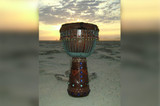Conga Masterclass - The Open Tone
Playing an open tone on the conga drum may seem like a fairly simple task, but during my 30 years of playing and teaching, I've noticed such a wide variety of approaches, techniques, and sound quality that I thought I would share some recommendations with you to help you get the most out of your congas.
If there was one piece of advice that I would give to any student, that would be a summary of what I hear the most experienced players and teachers telling their students. That would be to: Practice your fundamentals. Working on your basic tones and techniques is essential for not only mastering the instrument, but for making progress and not experiencing limitations in the future.
Although the open tone requires only an elemental understanding of drumming technique, producing a quality tone takes time, attention, and practice. It's not something that anyone can automatically do just because someone shows them how to do it. Anyone can hit the drum, but the percussionist makes music on the drums. This post is about helping you become a percussionist.
The open tone is the natural speaking tone of the conga drum. It is expressed on the instrument when the fingers are used as one unit to strike the drum head and get it resonating as fully as possible. To do this requires the use of what I call a 'percussive stroke,' proper finger alignment, proper hand to head alignment, and application of force.
The Percussive Stroke
The percussive stroke is achieved when the musician strikes the instrument using a relaxed and resilient technique. If there is excessive tension in your muscles or your movements are jerky and uncoordinated, you will probably find it difficult to produce the highest quality tones on your instrument. The percussive stroke uses gravity and momentum to not only carry the arm and hand towards the drum, it also uses the impact of the strike itself to send the hand and arm rebounding back to the original position. In this regard the percussive stroke represents a balance of forces where much of the original energy that is placed into the downstroke is recycled into the upstroke.
A percussive stroke is also fluid in nature. When striking the drum, both the elbow and wrist are active pivot points. The main stroke begins at the elbow moving the forearm down to the drumhead while the wrist keeps the hand and fingers trailing slightly. Just before impact the hand and fingers flatten out in a subtle whipping motion. At the moment of impact the hand begins to move back to the starting position. There is no pause between the downstroke and the upstroke.
Finger Alignment
The fingers work together as one unit which requires them to be not only held together, but also to be held flat. Holding your fingers flat so they extend in a straight line from the palm requires you to engage the muscles in your forearm because your fingers would typically be curved in a resting position. The thumb is held slightly up or out to avoid striking the side of the thumb on the edge of the drum.
Hand to Head Alignment
The open tone is played by alining the top of your palm (the pads below your fingers) with the bearing edge of the drum. The bearing edge is where the head folds over the shell. A common mistake is to not use enough of your fingers on the drum head when playing the open tone. I see a lot of players lining up their fingers so the bearing edge runs close to the middle of their fingers. This position usually results in tones that are thin sounding and week in volume.
Application of Force
To create a full resonant tone, I always recommend that players focus the weight of their hand into the lower part of their fingers. Although the entire area of the fingers is contacting the head, care can be taken to ensure that the lower part of the fingers make full and complete contact with the skin. If the fingertips and up being the primary carrier of energy, the result can be a tone that has a high degree of harmonics. These harmonics have a tendency to break up and disbursed the focus of the open tone.
Review
Key elements of an effective open conga open tone are:
- Always use a percussive stroke when playing a drummer percussion instrument.
- Align your fingers so they are functioning as one unit and keep your thumb in a position that doesn't strike the edge.
- Strike the drum so the top part of your palm lines up with the bearing edge.
- Throw the weight of your hand into the lower part of the fingers to ensure full and even contact.
This video clip from the play congas DVD will help you to produce a musical open tone.

Leave your questions and comments below. And thank you for taking the time to improve your drumming. There are many more resources available to you on the X8 website so take your time have a look around.
Kalani
To learn more about Kalani and his instructional materials, please visit the Kalani Das Google+ page.
Related product: Ultimate Conga Jam: Kalani's Ultimate Hand Percussion Series
Recent Posts
-
What is the Best Size Djembe for Beginners?
If you're new to the world of percussion and interested in learning the djembe, you're in for a t …16th Jul 2024 -
The Benefits of Becoming a Drumming Teacher: Transforming Passion into Profession
Why become a drumming teacher? Becoming a drumming teacher is an excellent way to share your pas …22nd May 2024 -
What Makes the Djembe Drum a Spiritual Instrument in African Music?
Origin and history of the Djembe drum The Djembe drum originates from West Africa and holds sign …16th May 2024





